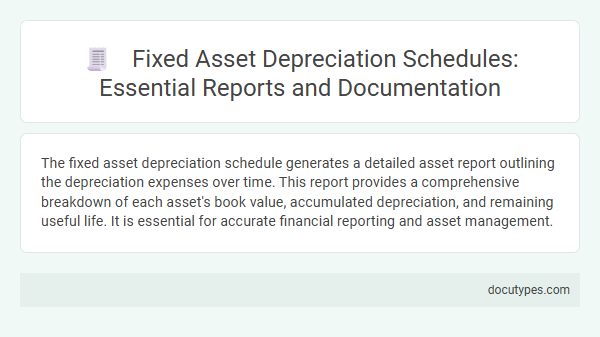The fixed asset depreciation schedule generates a detailed asset report outlining the depreciation expenses over time. This report provides a comprehensive breakdown of each asset's book value, accumulated depreciation, and remaining useful life. It is essential for accurate financial reporting and asset management.
Introduction to Fixed Asset Depreciation Schedules
Fixed asset depreciation schedules provide detailed information on the systematic allocation of an asset's cost over its useful life. These reports help organizations track asset value reduction and comply with accounting standards.
The depreciation schedule report typically includes asset descriptions, acquisition date, cost, accumulated depreciation, and book value. This information supports financial reporting and tax calculations by offering a clear view of asset depreciation over time.
Importance of Depreciation Documentation
Fixed asset depreciation schedules typically generate detailed financial reports showing the allocation of asset costs over time. These reports are crucial for accurate accounting, tax compliance, and asset management.
Maintaining thorough depreciation documentation ensures transparency and supports audit processes. Comprehensive reports help track asset value reduction and inform budgeting decisions.
- Compliance Report - Provides detailed depreciation data to meet tax regulations and legal requirements.
- Asset Register Report - Lists each fixed asset with its depreciation status and remaining book value.
- Financial Summary Report - Summarizes total depreciation expense impacting financial statements and cash flow management.
Key Components of Depreciation Schedules
| Report Type | Key Components | Description |
|---|---|---|
| Fixed Asset Depreciation Schedule Report | Asset Details | Includes asset name, identification number, purchase date, and acquisition cost essential for tracking. |
| Fixed Asset Depreciation Schedule Report | Depreciation Method | Specifies the accounting method used, such as straight-line, declining balance, or units of production. |
| Fixed Asset Depreciation Schedule Report | Useful Life | Defines the estimated period over which the asset will be depreciated, usually expressed in years. |
| Fixed Asset Depreciation Schedule Report | Opening and Closing Balances | Displays the asset's book value at the beginning and end of the reporting period to monitor value changes. |
| Fixed Asset Depreciation Schedule Report | Accumulated Depreciation | Shows the total depreciation expense recorded against the asset up to the report date. |
| Fixed Asset Depreciation Schedule Report | Depreciation Expense | Details periodic depreciation amounts, often monthly or yearly expenses that reduce the asset's value. |
| Fixed Asset Depreciation Schedule Report | Net Book Value | Represents the asset's current value after subtracting accumulated depreciation from the original cost. |
Types of Depreciation Methods
Fixed asset depreciation schedules generate reports detailing the allocation of asset costs over their useful lives. Common types of depreciation methods included in these reports are straight-line, declining balance, and units of production. Each method provides a different approach to expense recognition, impacting financial statements and tax calculations.
Mandatory Reports for Compliance
Fixed asset depreciation schedules generate mandatory reports critical for compliance with accounting standards and tax regulations. These reports provide detailed information on asset values, depreciation methods, and accumulated depreciation over time.
Your fixed asset depreciation reports typically include the Depreciation Expense Report, Asset Register, and Accumulated Depreciation Report. These documents ensure accurate financial statements and support audit requirements. Regulatory bodies often require these reports to verify correct asset valuation and depreciation practices.
Best Practices for Depreciation Reporting
Fixed asset depreciation schedules generate detailed financial reports that track the allocation of asset costs over their useful lives. These reports include information such as asset description, acquisition date, depreciation method, accumulated depreciation, and book value.
Best practices for depreciation reporting emphasize accuracy, consistency, and compliance with accounting standards like GAAP or IFRS. Timely updates and clear documentation ensure transparency and support informed decision-making for asset management.
Integrating Fixed Asset Records with Financial Statements
Fixed asset depreciation schedules generate detailed reports that integrate asset records with financial statements to provide accurate expense tracking and asset valuation. These reports facilitate compliance and financial analysis by aligning depreciation data with accounting records.
- Depreciation Expense Report - Summarizes periodic depreciation charges for fixed assets, supporting expense allocation in financial statements.
- Asset Ledger Integration - Links fixed asset records directly to the general ledger, ensuring real-time updates in financial reporting.
- Financial Statement Reconciliation - Aligns accumulated depreciation with the balance sheet, enhancing accuracy in asset valuation and net book value presentation.
Common Errors in Depreciation Documentation
Fixed asset depreciation schedules generate detailed reports tracking the allocation of asset costs over time. These reports ensure compliance and accuracy in financial statements.
- Incomplete Asset Information - Missing acquisition dates or cost details lead to incorrect depreciation calculations.
- Wrong Depreciation Method - Applying an unsuitable depreciation method distorts asset value and expense recognition.
- Failure to Update Schedules - Neglecting to record disposals or improvements causes inaccurate asset balances.
Your attention to these errors improves the reliability of depreciation documentation and financial reporting.
Digital Tools for Depreciation Schedule Management
Fixed asset depreciation schedules generate detailed reports outlining asset value reduction over time, including accumulated depreciation and book value. Digital tools for depreciation schedule management automate calculations, produce accurate reports, and provide real-time updates for compliance and financial analysis. Your ability to access these reports improves decision-making and asset tracking efficiency.
What Type of Report Is Generated for Fixed Asset Depreciation Schedules? Infographic

